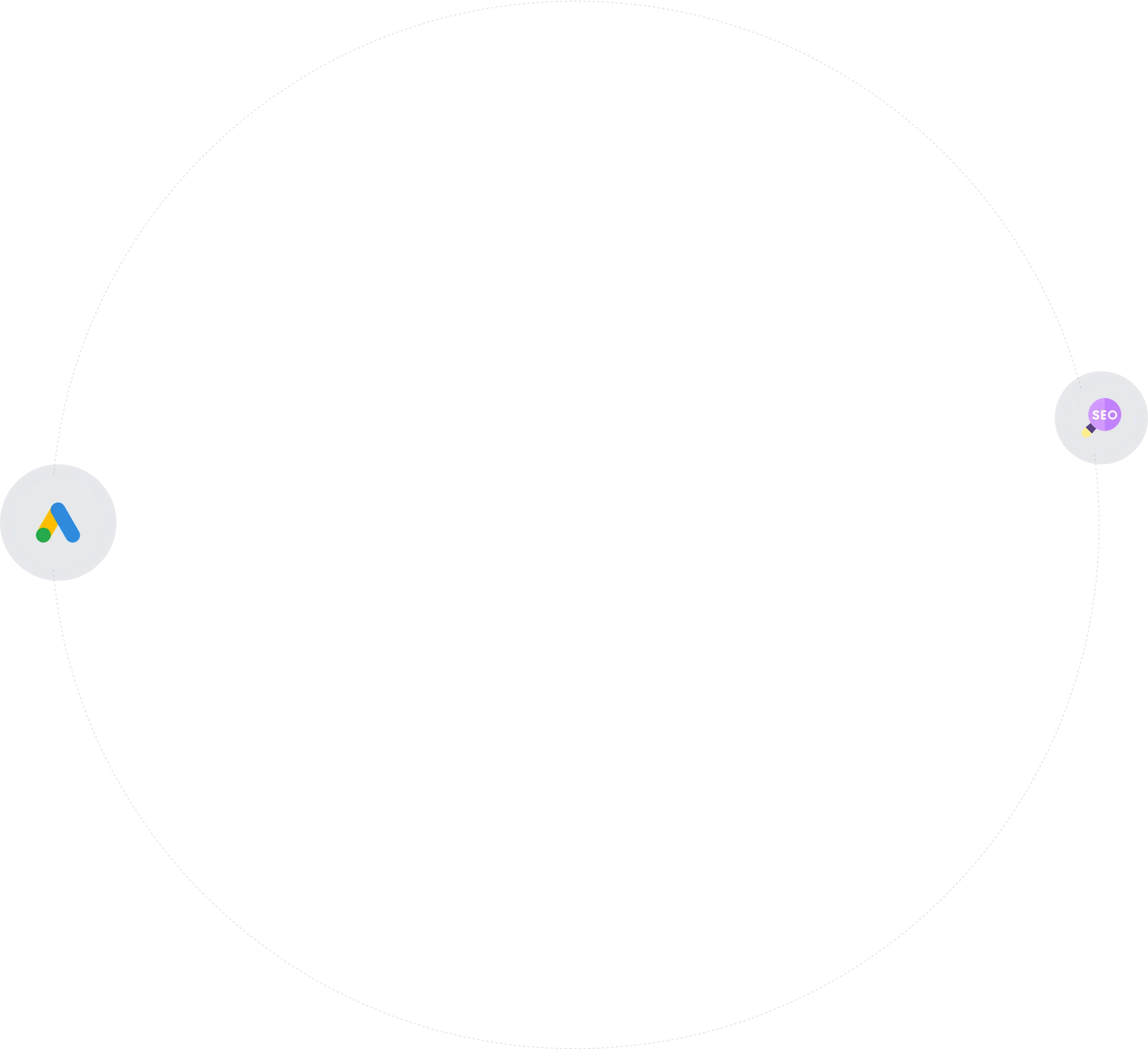
Google Display Ads: Effectively reach your own target group

.webp)

The most important facts in a nutshell






.webp)

Then now is the right time! Together we will turn your website into your strongest sales channel - with a clear strategy and measurable growth.
Get free adviceLooking for new ways to reach potential customers? Then Google Display Ads are just the thing for you! With this innovative form of online advertising, you can address your target group in a targeted manner and generate lasting enthusiasm for your company.
The Google Display Network includes over 2 million websites and apps on which your ads can appear. This means you can reach more than 90% of all internet users worldwide! By precisely targeting your campaigns according to interests, behavior and demographic characteristics, you can reach exactly the people who are interested in your offer.
The highlight? You only pay for actual clicks or interactions with your display ads! Thanks to powerful analysis and optimization tools, you always have an overview and can adjust your advertising in real time. So you get the most out of your online marketing budget!
Introduction to Google Display Ads
Google Display Ads offer an effective way to reach your desired target group. 35 million websites and apps as well as Google products such as YouTube and Gmail, you can address potential customers who are researching online in the Display Network. By selecting suitable target groups in Google Ads or Google Analytics, you can reach exactly the right people with your advertising — whether existing or new customers.
A big advantage of Google Display Ads is the variety of display ads formats. You can place ads in almost all sizes in the Google Display Network, from small banners to large-format advertising formats. Thanks to Google's AI technology, your display ads automatically adapt to the advertising space to improve performance. So you always reach your target group in the best possible way.
Google's AI-supported display campaigns also ensure continuous optimization of your advertising. Bid settings, creatives and target groups are adjusted within a few days to achieve your campaign goals. With Smart Bidding, you can optimize the number of conversions or the conversion value in each auction. This allows you to get the most out of your advertising budget.
Advantage
Description
Large range
Over 35 million websites, apps and Google products accessible
Diverse formats
Ads can be placed in almost all sizes in the Google Display Network
AI optimization
Automatic adjustment of bids, creatives and target groups
Smart Bidding
Optimization of Conversions or Conversion Value in Real Time
By the way: Advertisers who combine Google display campaigns with Google search ads achieve an average of 11% more conversions via search ads than those who only use search ads. It is therefore worth integrating both advertising formats into your online strategy in order to exploit the full potential.
Addressing target groups with Google Display Ads
By targeting specific interests, demographics and intentions, companies can target a display ad to potential customers from the desired target group.
Various target group segments are available for display, search, video, hotel and standard shopping campaigns, for example:
- Segments with common interests
- User-defined segments
- Detailed demographic characteristics
- Life events
- Ready-to-buy segments
- Segments with Self-Collected Data
By combining these target group segments, you can put together the ideal target group for your product or brand. For example, sports fans, environmental and nature enthusiasts or vegans can be addressed specifically.
Target Group Segment
Description
Target groups with interactions
Reach users who have already interacted with the website on Google search results, YouTube or other Google websites
Similar segments
Enable you to reach people with similar interests as existing customers
Ready-to-buy target groups
Includes people who actively engage with, search for or want to buy products or services
By using Google Display Ads, you can increase your brand awareness and generate more sales. Thanks to smart algorithms and machine learning, it is possible to target advertising precisely to the desired target group and thus ensure a high level of relevance.
Design of appealing display ads
To design Google Display Ads effectively, it is important to upload relevant assets such as images, logos and videos for responsive display ads. By combining these elements, different appealing ad variants can be created automatically that adapt optimally to different devices such as smartphones, tablets or desktop computers.
When selecting images for responsive display ads, up to 15 images can be uploaded in three formats: Landscape (1200 × 628), Square (1200 × 1200) and Portrait (900 × 1600). Each image should not exceed a maximum file size of 5,120 KB. For optimal performance, we recommend using 5-10 high-quality images per aspect ratio that clearly focus on the advertised product or service.
In addition to the images, ad titles and text lines, i.e. play an important role. These should be clearly formulated, contain a maximum of 80 characters (including spaces) and use the usual upper and lower case letters in German. The inclusion of prices, promotions or exclusive offers can make the ad even more attractive. It should also be clear where clicking on the ad will take you.
Recommended image sizes
Aspect ratio
Maximum file size
1200 × 628
Landscape format
5.120 KB
1200 × 1200
Square
900 × 1600
Portrait format
To achieve the best possible performance from display ads, Google recommends creating three to four ads per ad group. This allows you to test different combinations of images and text and make informed optimization decisions based on the performance data. Advanced format options such as asset optimization, automatically generated videos and native formats can be used to further improve the ads and adapt them to the target group.
Performance measurement of Google Display Ads
In order to optimally measure the success of your Google Display Ads, you should consider all relevant conversions. This includes not only direct conversions after a click on your ad, but also engaged-view and view-through conversions. These provide information about users who have seen your display campaign but have not interacted with it immediately and only perform a desired action later.
Customize the lookback windows of the recorded conversions to your individual business or product purchase cycle to obtain meaningful data. The automatic tagging of Google Analytics 4 gives you the most comprehensive insights into your Google Ads campaigns. You also want to find predefined target groups here, although these are less recommended today due to their lack of specificity.
Measured variable
Description
Recommendation
Conversions
Number of target actions executed after ad interaction
Track and individually evaluate all relevant conversions
View-through conversions
Conversions from users who have seen the ad but not clicked on it
Inclusion to capture the full impact of display ads
Conversion rate
Percentage of users who convert after being exposed to an ad
Optimize ad design and targeting to increase conversion rate
Cost per conversion
Average costs for a conversion achieved
Adjust bids and budgets to reduce costs per conversion
You can also use the performance reports in Google Ads to gain detailed insights into the performance of your display campaigns. The Performance Planner analyzes your historical campaign data and provides valuable recommendations for future optimizations, including optimal bidding and budget scenarios. With Google Analytics, you can also track the customer journey to conversions and determine the contribution of your display ads compared to other marketing channels.
Budgeting for Google Display Ads
When budgeting for Google Display Ads, it is important to keep an eye on the campaign goals. The cost per click (CPC) varies between €0.05 and €4.00 depending on the industry and ad type, in exceptional cases even up to €20. B2B products with higher margins have more leeway in terms of costs than cheaper B2C products.
To use the budget effectively, Google offers various bidding strategies. With Smart Bidding such as the target CPA (Cost Per Acquisition), bids can be automated and optimized in order to generate conversions to a predefined target from the budget. Manual CPC bids, on the other hand, allow the maximum click price to be set individually.
For optimal targeting of display ads, we recommend using target group segments from data you have collected yourself, such as website visitors or repeat buyers. In this way, potential customers with a high conversion probability can be found and targeted.
Bidding strategy
Description
Application
Target CPA
Automatic adjustment of bids to generate conversions at a specified target CPA from the budget
For campaigns with the aim of achieving as many conversions as possible at a certain price
Manual CPC bids
Individual Determination of the Maximum CPC Bid
For detailed control over bidding at keyword level
Bid adjustments
Adjustment of bids based on factors such as device type, location or time of day
To optimize campaign performance by targeting specific target groups
By combining different bidding strategies and carefully analyzing campaign performance, the budget for Google Display Ads can be managed effectively and the full potential of the display ads can be exploited. This allows you to target your advertising to the right target group and achieve your campaign goals.
Best practices for Google Display Ads
With a Google Display Ads account, you get access to all the features of Google Ads, including creating, managing and optimizing display ads, and there are some best practices you should follow to get the best results. First, we recommend regularly checking and testing conversion tracking. This way you can ensure that your ads are having the desired effect and that you are using your budget effectively.
Switching to Performance Max Campaigns can be worthwhile: Advertisers who switch their Google Display Campaigns to this format achieve on average over 20% more conversions with a similar or lower CPA. With Performance Max, you can reach valuable target groups across channels even more effectively.
Use responsive display ads, as these lead to twice as many conversions as static ads. Use the option of uploading up to 15 images in different aspect ratios:
Aspect ratio
Recommended image size
Landscape format (1. 91:1)
1200 x 628 pixels
Square (1:1)
1200 x 1200 pixels
Portrait format (9:16)
900 x 1600 pixels
Make sure to use high-quality images without artificial filters or distortions and focus on the advertised product. Avoid too much text or logos on the images to ensure legibility.
More tips for successful Google Display Ads:
- Use descriptions of up to 80 characters to provide additional information
- Create 3-4 ads per ad group to test different combinations
- Separate Remarketing Campaigns from Brand Awareness Campaigns
- Use advanced format options such as smart cropping or automatically generated videos
- Use Keyword Targeting by Uploading a List of Relevant Keywords
- Use the Google Ads automation tool to create and manage your ads
Regularly analyze the performance of your display ads and optimize your campaigns accordingly. With the right strategy and continuous optimization, you can effectively reach your target groups and exceed your conversion goals with Google Display Ads.
Conclusion: The future of Google Display Ads
Today, Google Display Ads are a powerful tool for acquiring new customers. Precise target group targeting based on behavior, interests and demographics enables relevant users to be addressed with pinpoint accuracy. In-market audiences and similar audiences provide access to users who are interested and ready to buy and who are similar to existing target groups.
In the future, these target group segments will continue to expand, particularly due to the growing use of mobile devices and apps. Advertisers should actively use in-market and similar audiences to acquire new customers and expand their reach.
Mobile-friendly and appealing ads in the Google Display Network are also becoming increasingly important in order to attract users' attention and increase the click-through rate. With an average of eleven interactions until a purchase is made, creative and targeted ad design is also crucial here. A/B testing helps to identify the best motifs and increase performance.
Google Display Ads therefore offer a wide range of opportunities to reach target groups in all phases of the customer journey — from initial contact to conversion. By combining remarketing, targeting new customers and targeted design, companies maximize the potential of display ads and increase their online success.
FAQ
How does targeting work with Google Display Ads?
With Google Display Ads, you can reach specific target groups. You can target users according to interests, demographics or behavior. Particularly interesting: You can differentiate between in-market audiences (users shortly before a purchase decision) and similar audiences (users who are similar to your existing customers).
What should I consider when designing my display ads?
Creativity is required! Upload relevant images, logos and videos. Responsive Display Ads automatically create different combinations of Responsive Ads. Also test format options such as asset optimization or native formats. Your shopping ads should contain product-related images and information. Regular testing of new assets leads to success!
How do I measure the success of my Google Display Ads?
Monitor all conversions, including ad interaction and view-through conversions, to capture users who act later. Customize lookback windows to your buying cycle. Google Analytics 4 gives you comprehensive campaign data and predefined target groups.
How do I make the best use of my budget?
Use your budget in line with your goals. Use smart bidding for automatic bid control to reach customers with a high conversion probability, even outside your defined target groups. Your own data, such as website visitors, is ideal for addressing existing customers. Get the most out of your budget!
Best practices for Google Display Ads?
Test and optimize regularly! Check your conversion tracking and increase the performance of your ads. Performance Max Campaigns bring up to 20% more conversions. Responsive ads perform better than static formats. Keep at it and you'll leave the competition behind!
Are you ready for rocket growth?
Arrange your personal consultation now and find out how we can help you get ahead in search engine marketing. Whether you run a small company or are responsible for a large corporation - we will find the right solution for you.


.svg)
.webp)
.webp)




.webp)





.webp)








